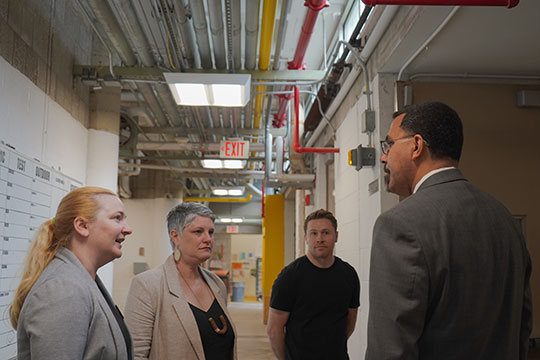SUNY Chancellor John King visits Alfred University as part of 64-campus tour

State University of New York Chancellor John B. King Jr. visited Alfred University on Wednesday, April 26, as part of his tour of the SUNY system. King took office on Jan. 9 and later that month began visiting SUNY’s 64 institutions. The campus tours will wrap up in early May.
King met with Alfred University administrators, including Mark Zupan, president, Beth Ann Dobie, provost and chief operating officer, Gabrielle Gaustad ’04, dean of the Inamori School of Engineering and vice president of Statutory Affairs, Lauren Lake, dean of the School of Art and Design and Performing Arts Division, and Brian Sullivan, dean of Libraries. He then toured facilities in the School of Art and Design and Performing Arts Division and School of Engineering, which are Alfred University’s statutory units.
Gaustad talked about the facility that will be home to the National Casting Center, which includes the foundry used by the University’s Sculpture and Dimensional Studies Program. The new foundry facility, located in the University’s former heating plant, will also host classes in physical metallurgy and refractories and be home to new foundry, forging, and blacksmithing clubs. The facility—which combines art and engineering disciplines in academic and co-curricular settings—reflects the University’s commitment to providing students with meaningful intersections.
King asked how students enrolled in the statutory programs participate in programs offered by the University’s private, non-statutory side, and vice versa. Gaustad said there is little distinction between the two, and students have the opportunity to participate in activities and take courses across the University.
“We’ve worked hard to have blurred lines for students. They don’t feel like there is an Alfred side and a SUNY side,” Gaustad said. “We’ve done a lot of work to make it seamless.”
The chancellor inquired about admissions and enrollment management services, which at Alfred University are centralized and serve all students. Lake said recruitment efforts are bolstered by an admissions counselor dedicated to the School of Art and Design and Performing Arts Division. Summer workshops which bring in high school students from around the world.
Gaustad pointed to outreach efforts—such as educational programs offered on campus for high school students— some of which aim to educate students on materials science. “The average high school student doesn’t understand the technical aspects of materials like ceramics and glass,” she said.
Zupan noted that two pillars in the University’s philosophy for providing an enriching college experience are intersections and mentorship. He referred to the “novel first-year courses” offered to new students in both the engineering and art schools—including the Foundations course in the art school and first-year experiential programs and activities in engineering—which allow student to explore a variety of intersections.
Sullivan added that mentorship is evident in an initiative in which the University’s librarians are assigned to work closely with and assist each student pursuing an undergraduate research project.
Following the opening discussion, Lake and Gaustad led King on respective tours of the School of Art and Design and Performing Arts Division, and Inamori School of Engineering, where the chancellor met with faculty and students. Sullivan led his visit to Scholes Library, where he met several members of the library staff.
The tour of the art school includes visits to the glass art studio; the digital lab ceramic satellite, where artwork can be 3-D printed; the indoor kiln facility; and MFA exhibitions in the Fosdick-Nelson Gallery. The engineering school tour included stops at the Inamori-Kyocera Fine Ceramic Museum and Paul Vickers Gardner Glass Center; and the McMahon Engineering Building, where he visited the Center for Advanced Ceramic Technology (CACT), the scanning electron microscope/focused ion beam/transmission electron microscope (SEM/FIB/TEM) labs; and the Ceramic Research, Education and Technology Enterprise (CREATE) Center.
